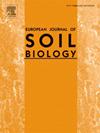沟施生物炭提高芝麻连作根际土壤微生物群和代谢物的机制
IF 3.3
2区 农林科学
Q1 ECOLOGY
引用次数: 0
摘要
在芝麻连作中施用生物炭可显著减少青枯病,提高产量,但成本高限制了其广泛应用。本研究利用宏基因组学和代谢组学分析,在4种样品类型(D0/D1:患病;H0/H1:健康;根际/非根际)中评估了3种生物炭施用策略(地表[BR3, 15,000 kg ha−1],垄作[BR4, 1,875 kg ha−1]和无生物炭[BR0]),分析了它们对芝麻土微生物群落的影响以及它们的功能和代谢特征。结果表明,与对照(BR0)相比,BR4显著提高了26.57%的芝麻产量。生物炭处理(BR3/BR4)提高了病株根际和非根际土壤放线菌的相对丰度,抑制了假单胞菌。amiense和S. indicum的BR3H0和BR4H0含量差异较大。我们观察到BR3D0脂肪酸代谢的破坏,这与连作芝麻的生长抑制有关。BR4H0处理显著增加了丙酮酸脱氢酶的相对丰度和嘧啶核糖核苷酸从头生物合成的超途径。经BR4处理的健康植株根际中c17 -鞘氨氨酸(+2.79个百分点)和6-[3-(二羟基苯基-甲基)-甲氧基丁基]-苯二氮唑(+0.18个百分点)含量高于患病植株。偏最小二乘判别分析(PLS-DA)发现,茉莉内酯和三羟甲基胺甲烷在正离子模式下是关键的代谢物判别因子,而牛磺酸氧胆酸和棕榈酸在负离子模式下是关键的代谢物判别因子。这些结果表明,在芝麻连作系统中,以减量施用生物炭(1875 kg ha - 1)可以改善土壤微生物结构、功能和代谢物组成,最终提高产量。本文章由计算机程序翻译,如有差异,请以英文原文为准。
Mechanisms of furrow-applied biochar in enhancing rhizosphere soil microbiota and metabolites in continuous sesame cropping
Biochar application significantly reduces bacterial wilt and boosts yield in continuous sesame cropping, but high costs limit its widespread use. This study used metagenomic and metabolomic analyses to evaluate three biochar application strategies (surface [BR3, 15,000 kg ha−1], furrow [BR4, 1,875 kg ha−1], and no biochar [BR0]) across four sample types (D0/D1: diseased; H0/H1: healthy; rhizosphere/non-rhizosphere), analyzing their effects on microbial community as well as their functional and metabolic profiles in sesame soil. The results showed that BR4 significantly increased sesame yield by 26.57 % compared to the control (BR0). Biochar treatments (BR3/BR4) enhanced the relative abundance of Actinomycetota while suppressing Pseudomonas in rhizosphere and non-rhizosphere soils of diseased plants. Sphingobium amiense and S. indicum were differentially abundant in BR3H0 and BR4H0, respectively. We observed disruption of fatty acid metabolism in BR3D0, which was linked to growth inhibition in continuously cropped sesame. BR4H0 treatment significantly increased the relative abundance of pyruvate dehydrogenase and the superpathway for de novo biosynthesis of pyrimidine ribonucleotides. The rhizospheres treated with BR4 from healthy plants showed higher levels of C17-sphinganine (+2.79 percentage points) and 6-[3-(dihydroxyphenyl-methyl)-methoxybutyl]-benzodioxole (+0.18 percentage points) compared to diseased plants. Partial Least Squares Discriminant Analysis (PLS-DA) identified Jasmine lactone and Tris(hydroxymethyl)aminomethane as key metabolite discriminators under positive ion mode, as opposed to Taurochenoxycholate and Palmitic acid under negative ion mode. These findings suggest that furrow-applied biochar at a reduced rate (1,875 kg ha−1) can enhance soil microbial structure, function, and metabolite composition, ultimately improving yield in continuous sesame cropping systems.
求助全文
通过发布文献求助,成功后即可免费获取论文全文。
去求助
来源期刊

European Journal of Soil Biology
环境科学-生态学
CiteScore
6.90
自引率
0.00%
发文量
51
审稿时长
27 days
期刊介绍:
The European Journal of Soil Biology covers all aspects of soil biology which deal with microbial and faunal ecology and activity in soils, as well as natural ecosystems or biomes connected to ecological interests: biodiversity, biological conservation, adaptation, impact of global changes on soil biodiversity and ecosystem functioning and effects and fate of pollutants as influenced by soil organisms. Different levels in ecosystem structure are taken into account: individuals, populations, communities and ecosystems themselves. At each level, different disciplinary approaches are welcomed: molecular biology, genetics, ecophysiology, ecology, biogeography and landscape ecology.
 求助内容:
求助内容: 应助结果提醒方式:
应助结果提醒方式:


